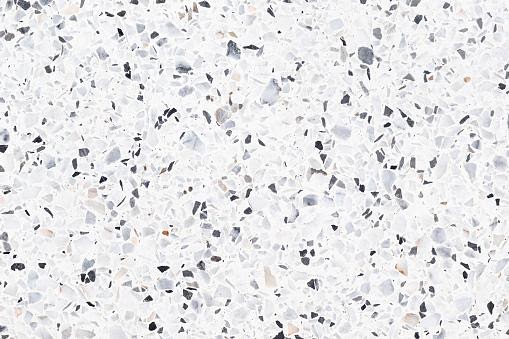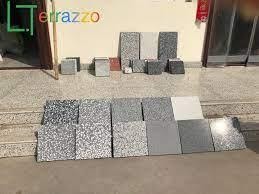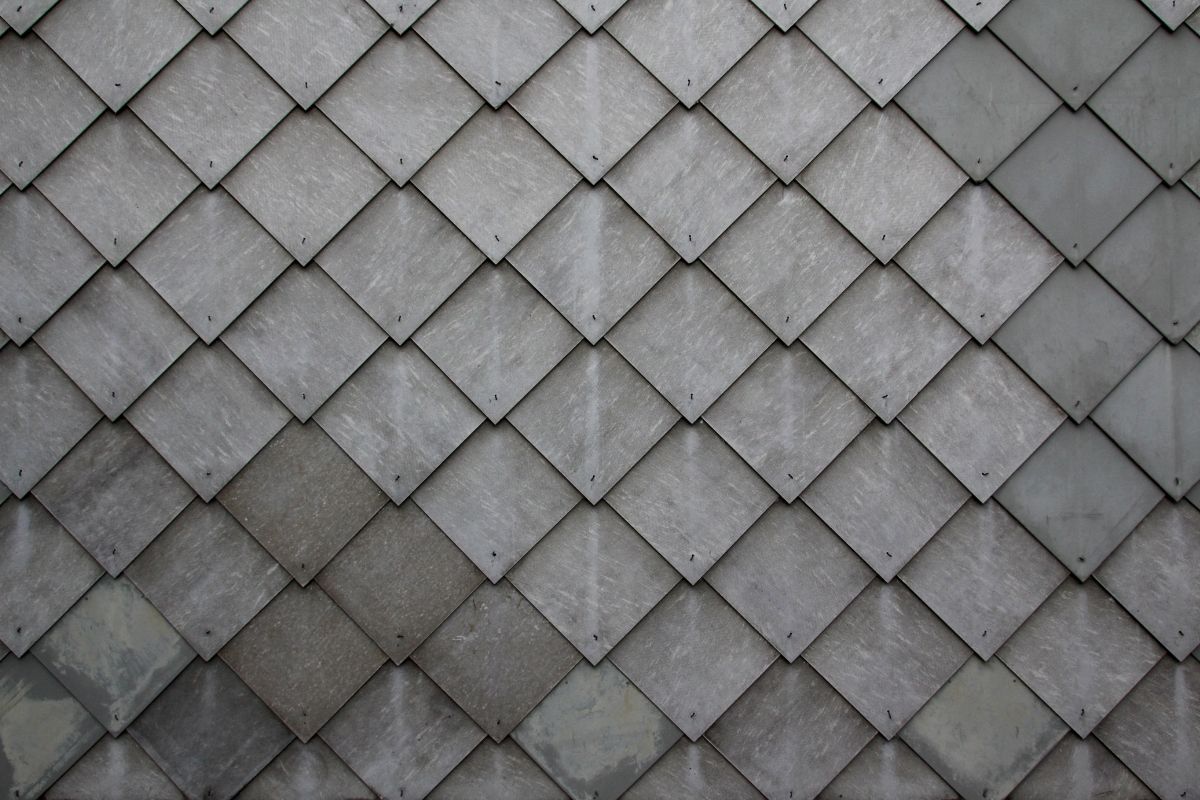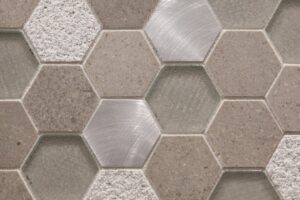
Terrazzo tiles flooring is suitable for usage both inside and out. Airports, healthcare facilities, educational institutions, and residential areas are the primary locations for this kind of lighting. Terrazzo tiles were one of the first composite materials to be recycled. Typically used as a floor, stair, and wall finish. Terrazzo—or your simple mosaic—has made a triumphant return to the interior designer’s fashion palette, and how! With marble, quartz, or granite chips atop a smoothed and polished concrete basis, this speckled surface is currently a trendy home décor trend.
Terrazzo: In Portland cement, modified Portland cement, or resinous mix, it is blended with marble, quartz, granite, and glass fragments. Terrazzo is created by pouring, curing, grinding, and polishing. Floors may be poured in situ or premade tiles might be used.
In situ, the mixture is mixed with either a cement binder such as concrete or an epoxy resin. This slurry is then poured into position to create a monolithic cast flooring system. Mineral pigments are used to provide a range of color possibilities.
To create precast tiles, molds are used to shape the slurry before it is poured. It is then cooked until solid in an oven or kiln.
A water jet is used to cut the material into various forms, patterns, and logos. Terrazzo tiles flooring may be altered to create one-of-a-kind floor designs.
Terrazzo Flooring Advantages
- Attractive and aesthetically pleasing:
- Unique Flooring: Available in a variety of colors, textures, aggregates, and bespoke designs.
- Heat Resistance: Extremely effective at keeping heat, making it ideal for use with underfloor heating systems.
- Mold and bacterium resistance
- Long-lasting, low-maintenance
- Seamless flooring: may be poured in place
Cons of Terrazzo tiles Flooring
- Expensive: fluctuates according on the aggregate type selected
- Failure due to cracks: if not placed correctly, cracks may occur
- Cold and hard underfoot
Aesthetics
- Colours: There are an infinite number of colour combinations and many designs are possible, exactly as if we were designing on a blank canvas. Precast tiles come in a range of conventional sizes. Square or chamfered edges are possible. Terrazzo tiles is cast in-situ in 4’x4′ portions to provide a uniform distribution.
- 300,400,600x600mm tiles (not exceeding 600mm in its greatest dimension).
- Thickness: The most typical thicknesses are 1/4″,1/2″,3/8″, and 5/8″.
- Epoxy-based tiles are thinner than cement terrazzo tiles.
- Cut to size: order according to design.
Terrazzo tiles Flooring Surface Finishes:
- Polished: a high-gloss, mirror-like finish that creates a modern look for home and commercial buildings.
- Honed: matte finish, ideal for anti-slip surfaces.
- Sandblasted: Similar to the Matt finish but with an anti-slip surface.
- Antiqued: Preferable for Traditional, Rustic, and similar styles.
Terrazzo tiles Floor Types and Installation Techniques:
What is the best way to install a terrazzo tiles floor?
Terrazzo tiles floors may be put in situ or as tiles. Confirm with the terrazzo tiles installer the kind of aggregates, colors, and divider strips.
- Preparation of the surface
The top layer of concrete is removed to provide a firm connection between the concrete and terrazzo tiles. Any fissures present on the concrete surface are filled. The floor is leveled, and the moisture mitigation system eliminates any moisture present.
- Use divider strips in accordance with the design
Affixed to the flooring, divider strips (metal or plastic) separate the colors, design, and control of expansion joints.
- Mix terrazzo tiles
Using mixing equipment and according to the manufacturer’s requirements, mix the terrazzo.
- Pour terrazzo
After installing the divider strips, pour terrazzo tiles onto the flooring area and spread and distribute additional aggregates such as marble chips and glass pieces evenly throughout the floor using a trowel. Additional chips may be poured to make the mixture denser.
- A mechanical roller is next used to compress the floor, removing extra cement and water. Allow 48 hours for the floor to cure.
- After the floor has set, smooth and polish the surface using a grinding machine.
- Fill any pinholes with grout mixture.
- Polish and seal the surface according to the manufacturer’s instructions. Terrazzo made of cement must be treated with a water-based sealer to avoid staining.
Considerations for the Future
These floors are designed to endure the whole life of a structure. Re-sealing the flooring using environmentally friendly solutions is possible. They are recyclable. A significant portion of the floor is composed of naturally occurring materials/recycled content that emits no VOCs; as such, it is a component of sustainable green building.
Terrazzo flooring innovation: Terrazzo tiles floors are integrated with light-conducting tubes to produce a dynamic light experience. When combined with light, movement, and shadows, the lights produce a sparkling appearance. You can read about These tips that will help you utilize your terrazzo tiles by clicking here.
Popularity of Terrazzo tiles

Terrazzo tiles have actually ‘floored’ us since Pinterest included them in its 2018 Trends Report! The roots of this exquisite flooring finish date all the way back to the 1400s in Venice, Italy. Ancient Italian villas had elaborately patterned terrazzo tiles flooring that has often weathered the test of time and continues to look stunning today. Terrazzo tiles were a prominent fashion in the 1970s and 1980s Indian houses, and their popularity is resurgent.
Regardless of how it is fashioned, it compliments a wide variety of décor ideas, from minimalist to explosive…hence its appeal. Terrazzo tile’s colors are essentially limitless, and a large number of chip and substrate combinations are imaginable. Additionally, you may make bespoke combinations to fit any color palette. Additionally, it is a very durable surface since it is entirely waterproof, non-porous, and extremely hard-wearing.
The Advantages of Using Terrazzo tiles in Home Interiors
What are the advantages and disadvantages of terrazzo tiles? Continue reading to make an educated choice.
Terrazzo tiles are a cost-effective material that works with any budget. Terrazzo tiles of good quality are available for as little as Rs 40 per square foot, which is far cheaper than the cost of real stone. Terrazzo tiles may cost up to Rs 250 per square foot, depending on the substrate and the chips used.
- It may be customized to match your décor, and you can choose from a variety of colors.
- Terrazzo tiles may be cast in situ and molded to the desired profile.
- This material is very durable and improves in appearance with age and usage.
- Polished terrazzo tiles flooring are very slick. Water that has spilled on the floor might be difficult to spot, and unless spills are cleared up immediately, they can result in a serious fall.
- To pour terrazzo tiles, skilled craftspeople are required. Ascertain that they have the experience necessary to do the task appropriately.
- The surface may be refinished an unlimited number of times by grinding and repolishing.

